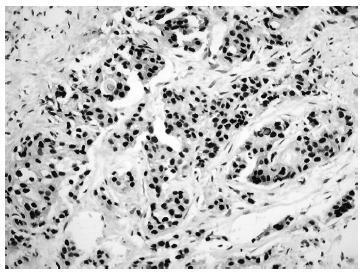Summary
Revista Brasileira de Ginecologia e Obstetrícia. 2016;38(10):512-517
10-01-2016
Triple-negative breast carcinomas (TNBCs) represent a heterogeneous group of neoplasias, even though they generally exhibit a clinically more aggressive phenotype, and are more prevalent in young women. To date, targeted therapies for this group of tumors have not been defined. The aim of this study was to evaluate the frequency of the apocrine subtype in TBNCs from premenopausal patients as defined by the immunohistochemical expression of the androgen receptor (AR) and its association with: histological type; tumor grade; proliferative activity; epidermal growth factor receptor (EGFR) expression; and a basal-like phenotype.
A total of 118 tumor samples from patients aged 45 years or younger were selected and reviewed according to histological type and grade. Ki-67 expression was also evaluated. Immunohistochemical expression of the AR, basal cytokeratin ⅚, and EGFR expression were analyzed in tissue microarrays. The apocrine subset was defined by AR-positive expression. The basal-like phenotype was characterized by cytokeratin ⅚ and/or EGFR expression.
An apocrine profile was identified in 6/118 (5.1%) cases. This subset of cases also exhibited a lower rate of Ki-67 expression (17.5% versus 70.0%, p= 0.02), and a trend toward a lower histological grade (66.7% versus 27.9%, p= 0.06).
The apocrine subtype of TNBCs is rare among premenopausal women, and it tends to present as carcinomas of lower grade and lower proliferative activity, suggesting a less aggressive biological phenotype.
